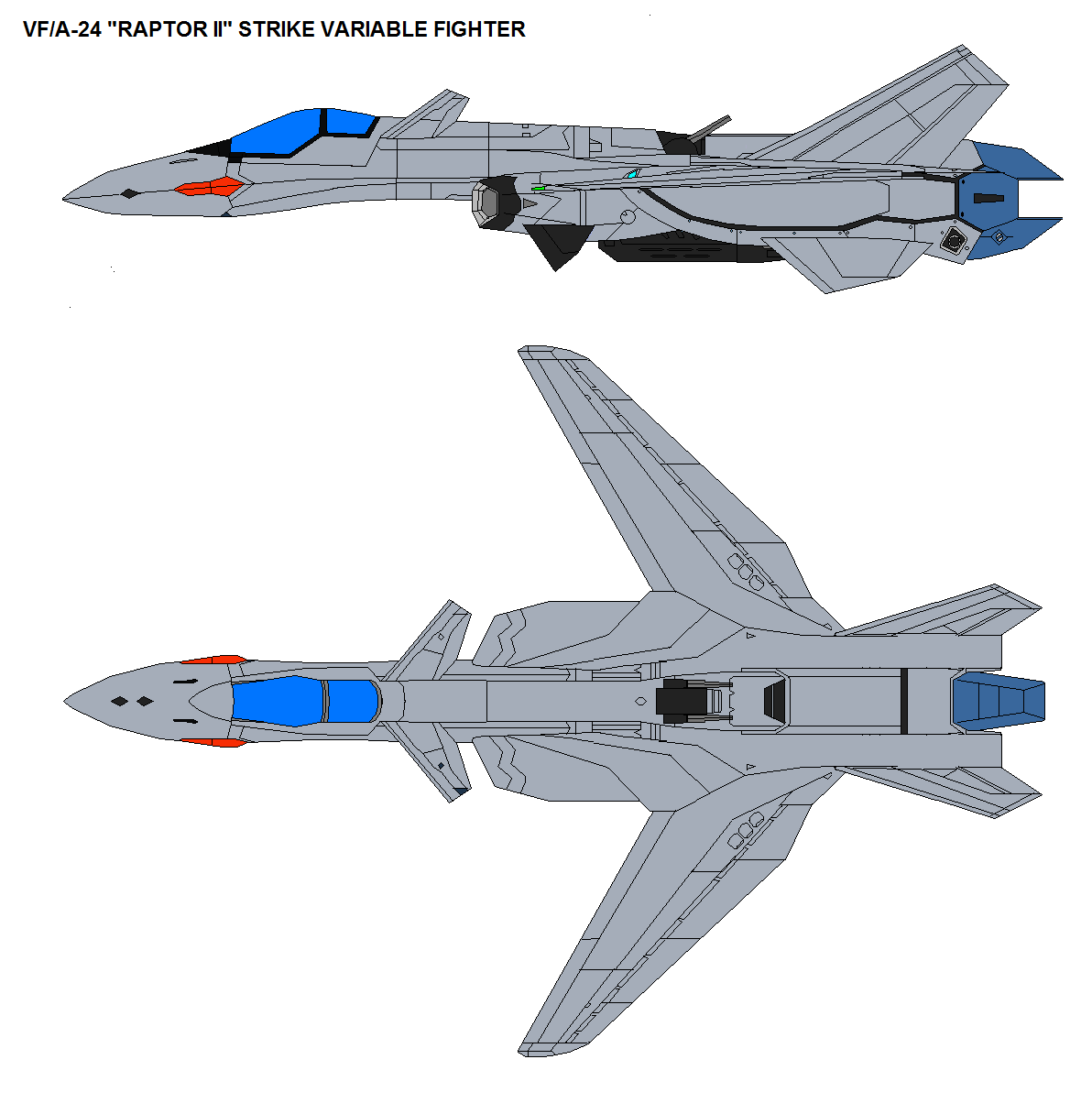HOME | DD
 NavalMadTurtle — VF-A-24 Raptor II Strike Variable Fighter
NavalMadTurtle — VF-A-24 Raptor II Strike Variable Fighter

#fighter #macross #robotech #veritech
Published: 2014-09-26 21:01:22 +0000 UTC; Views: 3472; Favourites: 30; Downloads: 12
Redirect to original
Description
VF/A-24 "RAPTOR II" STRIKE VARIABLE FIGHTERBACKGROUND
When the Super Nova project concluded, and the YF-19 was declared winner, no one ever dreamed the project would end up being so expensive. With numerous cost over runs and delays ( wich cost even more ), the project faced severe limitations on procurement and deployement. Just a few years after the "Blazer/Excallibur" went into IOC the need was seen for a low cost alternative. As many branches of the New Unity Armed Forces were faced with increasing accident rates due the age and wear of their existing Valkyries, a new "Joint Services" program was initiated to provide a fighter more inline with the philosophy that produced the VF-11 than that wich produced the VF-19. At first anyway. But as with many great designs the "Joint Attack Valkyrie Advancement-Light Normalized," or "JAVALiN" as it became known, was transformed into a new and awsome platform. Hense the "Hi-Manoeuverability Joint Strike Variable Fighter," or JSVF-HM was borne.
Dubbed the "Raptor II," after the winner of the first real advanced fighter project, the ATF program of the United States. This fighter was a marval of modern program management techniques and AI aided and simulated developement. After only two squadrons were fully equiped with the fighter, a new and greatly enhanced ( and even lighter and CHEAPER!! ) variant was developed. This new tail-less design was created based on UAV data collected over the years and evaluated, which proved that with the aid of three-dimentional thrust vectoring, a FULLY tailess aircraft was possible. If it was well balanced.
For this project, the old competitors Shinsei Industries and General Galaxy teamed up against newer competitors, and created a lightweight fighter that combined many elements of the lessons learned from the Super Nova project. Including the 3-d vectored thrust and the main weapons systems of the VF-22, and many advanced aerodynamic and reactional techniques developed on the M7's Kai Valkyrie, and with contributions by Bofors, in their first forray into fighter design (although a minor partner).
RPG STATS
Vehicle Type:
YF-24 (Prototype, Project White Dwarf, full tail )
VF/A-24A Raptor II ( UNAF/N variant--tail-less FSW/canard layaout )
VF/A-24MJ/S Raptor II ( UNSM variant--tail-less delta, two -J- or four -S- head lasers )
Class: Advanced Variable Fighter
Manufacturer: Shinsei Industries/General Galaxy
Crew: One pilot wearing customized Tactical Life Support System.
MDC BY LOCATION:
Thrusters (2) 165 each
Main Body 325
Main Wings (2) 150 each
Tails/Canards (2/2) 75 each
Stealth Gun Pod 120
Reinforced Pilot Compartment/Escape Pod 150
External Fold Generator (1, optional) 100 each
SPEEDS:
FLYING, FIGHTER CONFIGURATION: Mach 3.5+ (2345 mph/3572 kmph) max speed at 10,000 meters or less above sea level. Mach 5.06+ (3390 mph/5085 kmph) max speed at 10,000-30,000 meters above sea level. Mach 17 (11.520 mph/18.360 kmph) max speed at 30,000+ meters above sea level. Cruising speed is usually Mach 5-6. Maximum rate of ascent is "around 62,000 meters/minute." G limits are "greater than +60.0 to -45.0 Earth gravities."
MAX ENGINE THRUST: 68,500 kg in an atmosphere, 78,950 kg in space. The maximum thrust is automatically limited in an atmosphere due to coolant problems with the optional air intake systems for the engines..
STATISTICAL DATA:
HEIGHT: 3.9 m
WIDTH: 13.87m
LENGTH: 16,5m
WEIGHT: Classified, "less than an AVF," maximum weight in space with optional fold booster is 48,305 kg (weights beyond that exceed theoretical safe limit for fold booster).
CARGO: Small compartment behind pilot's seat for personal belongings.
POWER PLANT: One 72,500 kg Shinnakasu Industry/Pratt & Whitney/Rolls Royce FF-2550F thermonuclear turbine engines, designed for dual atmosphere/space use with optional concealed trapezoidal air intakes for use in an Earth-type atmosphere. One 3-dimensional independentent convergent/divergent exhaust are equipped on the FF-2550F for greater maneuverability and V/STOL performance. In addition, many Pratt & Whitney HMM-6J high-maneuverability vernier thrusters are mounted on the wingtips, vertical stabilizers, nose, and other key locations for added performance. Additional thruster options include an external fold generator developed for use with Project Super Nova.
WEAPON SYSTEMS:
1. ANTI-AIRCRAFT LASERS: The Raptor II mounts two( standard and J models ) to four ( S models )anti-aircraft lasers on its head, very similar to those originally found on the older VF-1 Valkyrie design. These lasers are designed for use in air combat skirmishes but are mostly used for defensive purposes. Due to the placement of the head in fighter and gerwalk modes the lasers can only be fired rearward. In addition to their use as weapons, the lasers can also generate a continuous beam useful for cutting.
o PRIMARY PURPOSE: Defense
o SECONDARY PURPOSE: Anti-aircraft
o RANGE: 4000 feet (1200 m)
o DAMAGE: 1D6 M.D. per laser; 2D6 M.D. dual fire.
o RATE OF FIRE: The lasers can be fired in rapid pulses up to 4 blasts per round. In addition, the lasers can all be fired as one continuous beam for double damage. This takes up all the Raptor II's attacks for the melee round and cannot be used against moving targets.
o PAYLOAD: Effectively Unlimited.
2. MAULER REB-23 LASER GUNS: Two semi-fixed laser guns are mounted in the wings of the VF/A-24, near the base of the wing where it connects to the main body. These lasers can be fired in any mode (the beams exit the hip-mounted wing units in soldier mode) but can only be aimed along the front arc of the mecha (max angle is about 45 degrees in any direction from the nose).
o PRIMARY PURPOSE: Anti-mecha
o SECONDARY PURPOSE: Air-to-ground strafing runs
o RANGE: 4000 feet (1200 m)
o DAMAGE: 1D4x10 M.D. per laser.
o RATE OF FIRE: The laser can be fired in rapid pulses up to 4 blasts per round. A rapid fire blast counts as a burst of up to 4 shots.
o PAYLOAD: Effectively Unlimited.
o
3. BIFORS BML-02S ALL-ENVIRONMENT RAPID-FIRE MICRO-MISSILE CLUSTERS: The VF/A-24 is armed with eight internal BML-02S missile launchers that were designed for the General Galaxy VF-22. The launchers are mounted in the forward ventral sections of the craft. Any type of UN Spacy mini-missiles can be used by the launchers, including the high-maneuverability mini-missiles recently developed by the UN Spacy. Armor-piercing MMs are standard issue, however. Although the Raptor II has eight missile launchers they all feed from the same missile bay. Therefore the total number of missiles carried is available should any launcher ( or shoulder ) be disabled.
o PRIMARY PURPOSE: Assault
o MISSILE TYPES: Any type of UN Spacy Mini Missile, including the new High Maneuverability Mini Missiles (HMMMs).
o RANGE: Varies with missile type, typically 1 miles (1.6 km).
o DAMAGE: Varies with missile type, typically 1D4x10 M.D.
o RATE OF FIRE: Volleys of 1-8 missiles. The rate of fire of the BML-02S launcher is equal to the pilot's combined number of attacks; and the pilot can fire all of his missiles in a single round if he has six or more attacks.
o PAYLOAD: 4 missiles per launcher; 32 missiles total
o
4. HOWARD/GENERAL DYNAMICS GV-17L GUN PODS: For a main external weapon, the VF/A-24 contains the new stealth gatling gun pod produced by Howard Industries and General Galaxy. These gun pods are the same as the ones used for the VF-22 and are mounted in a specially designed storage bay located on the underside centerline of the craft in fighter mode, similar to the gatling gun used by the VF-17 Nightmare. In Gerwalk or Soldier modes the gun pod can be ejected from it's bays and used by one or both of the VF-22's hands. The gun pod can fire in any mode; it fires out of a special concealed port when stored in Fighter mode.
Like the original GU-11 gun pod used by the VF-1 Valkyries, the GV-17L gun pod does NOT use clips of ammo, but instead have a large internal supply of ammo stored in the barrel of the pod. This allows the GV-17L to contain a larger supply of ammo and bypasses the need to reload while in the field. Once exhausted, the gun pod can only be reloaded by trained technicians at a supply base.
o PRIMARY PURPOSE: Assault
o SECONDARY PURPOSE: Anti-mecha
o RANGE: 4000 feet (1200 m)
o DAMAGE: Does 4D6 M.D. for a short burst, 1D6x10 M.D. for a long burst, or 2D6x10 M.D. for a full melee burst.
o RATE OF FIRE: Equal to the number of combined attacks of the pilot.
o PAYLOAD: 800 rounds, equal to 80 short bursts, 40 long bursts, or 20 full melee bursts. Once depleted, the gun must be reloaded by a service technician at a UN Spacy base or starship.
5. WING HARD POINTS: The VF/A-24 has four( six on MJ and MS models ) fixed hard points (two per wing) which can be used to hold a variety of different ordinance payloads, including long ,medium, or short range missiles, or even the new medium-range high-maneuverability (MRHM) missiles. One long range, one MRHM, 3 medium range, or 5 short range missiles can be mounted per hardpoint. A variety of other hardpoint stores can also be fitted, like ECM pods, Chaff/Flare pods, Sensor pods, or a large variety of bomb loads. Usually long range, medium range, or MRHM missiles are used.
NOTE: Due to the location of the hard points, ALL missiles must be fired or ejected before the VF/A-24 can convert into battloid mode. For this reason the missiles mounted on the hard points are usually fired within the first few passes of an attack.
STANDARD EQUIPMENT FOR THE VF/A-24:
• ACTIVE AERODYNAMIC CONTROL SYSTEM: The Active Aerodynamic Control System is partly responsible for the mecha's high fighter mode dodge bonus. The new feature, pioneered by the Project Super Nova, constantly monitors the Valkyrie's position inside it's flight envelope, and makes changes to the sweep, and to some extent the shape, of the control surfaces as deemed necessary by the highly advanced flight control computer.
• VF-19M STYLE OPTICS: The Raptor II utlilzes the optics system developed for the Marine Blazer. It has a large "fly-eye" digital composite camera array ( DCCA ) in the head that produces extremely high resolution stereoscopic images for 3d rendering in the vertual cockpit or later for analysis and BDA. The many cameras integrate their images with a special computer subprocessor made by Matrox-Honeywell.
• VIRTUAL ENVIRONMENT COCKPIT: The VF/A-24 is equipped with the innovative new cockpit layout pioneered by the YF-19 that provides monitors below and around the pilot in addition to the HUD cockpit dome. In flight, these monitors display what is below and behind the aircraft, giving the pilot a tremendous field of view that is unparalled by any other aircraft (with the possible exception of the YF-21's brain-direct imaging system). This wide view in addition to the combat computer's cockpit overlays give the VF/A-24 a +1 to dodge and initiative rolls in addition to any other bonuses.
• ACTIVE STEALTH SYSTEM: The VF/A-24 is equipped with a revolutionary stealth system that when activated renders the craft almost invisible to standard sensors such as radar. Unlike passive stealth systems like those used by the VF-17 Nightmare or the old USAF F-117, the VF/A-24's stealth system is an ACTIVE stealth that actually bends radar waves around the mecha rather than reflecting them. When activated, this system gives the VF/A-24 a +3 on initiative and a +1 to strike at all times.
• AUTO-PILOT: The VF/A-24 is equipped with a computerized auto-pilot, allowing the pilot to relax or even sleep during long voyages. The auto- pilot can be programmed with a single destination or a complex flight plan involving multiple speeds, directions, and destinations. The onboard computer will alert the pilot when the fighter is near its destination, and can also be set to automatically signal when sensors detect objects near the mecha. The auto-pilot was designed with long intra-system space journeys in mind.
• COMBAT COMPUTER: The VF/A-24 is equipped with a combat computer that can store and analyze data during combat with hostile forces. Data collected by the combat computer can be viewed by the pilot either on standard HUD displays included in the cockpit viewports or on cockpit video monitors, allowing the computer to display large amounts of data to the pilot and even highlight enemies and missile attacks with overlaid graphics. The combat computer tracks and identifies specific enemy targets, and has a database of over 10,000 images stored in memory. The computer can identify and track up to 250 targets simultaneously.
• ESCAPE POD: The entire reinforced cockpit of the VF/A-24 is a detachable escape pod that can be jettisoned when the mecha is destroyed. The ejected cockpit does not contain thrusters, but does contain a powerful locator beacon and an integrated life support system that can support the pilot for up to 24 hours after ejection. The pod is also equipped with parachutes in case of ejection in an atmosphere. The combat computer is programmed to automatically eject the escape pod if the mecha is destroyed (main body MDC reduced to 0), but this can be overridden if the pilot is feeling suicidal for some reason.
• EXTERNAL AUDIO PICKUP: Range: 300 ft (91.5 m). A sound amplification system that can pick up normal conversation up to 300 feet away.
• HEAT AND RADIATION SHIELDS: Special shielding prevents the penetration of life threatening head and radiation. A radiation detection and alarm system are linked with the shields and will sound an alarm if there is a rupture in the shields and what the levels of radiation are.
• HOMING SIGNAL: The escape pod of the VF/A-24 is equipped with a homing device that enables rescue teams to locate a disabled craft or ejected life pod. The range of the signal is 400 miles (640 km). Most valkyries and UN Spacy ships can key on and track/locate specific signals, and the onboard computers will automatically notify their pilots if such a signal is detected.
• LASER TARGETING SYSTEM: Range: 100 miles (160 km). Used for increased accuracy in the striking of enemy targets and is partly responsible for the mecha's strike bonus.
• LOUDSPEAKER: A loudspeaker system is built into the craft, which can be used to amplify the pilot's voice up to 90 decibels.
• OPTICS: INFRARED: Range: 2000 feet (610 m). This optical system projects a beam of infrared light that is invisible to the normal eye, but detectable by the mecha's sensors. The system allows the pilot to detect hidden/concealed objects by their IR reflectiveness. The beam will be visible to anyone with IR sensitive optics, however.
• OPTICS: NIGHTVISION: Range: 2000 feet (610 m). A passive light image intensifier that emits no light of its own, but relies on ambient light which is electronically amplified to produce a visible picture.
• OPTICS: THERMAL IMAGER: Range: 2000 feet (610 m). A passive optical heat sensor that detects infrared radiation projected by warm objects and converts that data into a false-color visible image. The system enables the pilot to see in the dark, in shadows, and through smoke, and also adds a +10% bonus to pilots using a tracking skill.
• PILOT FLIGHT SUIT AND HMD HELMET: The VF/A-24 comes with a custom-designed flight suit for the pilot instead of the standard UN Spacy-issue design used by most Valkyries. This flight suit consists of an upper and lower g-suit that promotes circulation even during high-g turns, thus decreasing the possibility of pilot's blacking out in combat. The flight suit also comes with a specialized HMD helmet which can display computer graphics and overlays over what the pilot sees, providing additional information. The one disadvantage of the flight suit is that it is customized for the VF-22 and VF/A-24 and is NOT usable in other aircraft.
• RADAR: 200 mile (321 km) range.
• RADIO/VIDEO COMMUNICATION: Long range, directional communications system with satellite relay capabilities. Range: 600 miles (960 km) or can be boosted indefinitely via satellite relay.
• SELF-DESTRUCT: To prevent capture of a Valkyrie fighter by the enemy, the pilot can activate the VF/A-24's self-destruct system, which will cause the fighter to explode after a delay of up to 60 minutes (time is set by the pilot). The explosive damage is contained within a 20 foot (6 m) area and inflicts 1D6x10 M.D. to everything within the radius of the explosion. All internal systems are obliterated. The escape pod will be automatically ejected prior to the explosion unless the pilot overrides the ejection sequence.
• STANDARD SURVIVAL KIT: All valkyries come equipped with a portable survival kit. Inside the small reinforced box is a medium-sized flashlight, two hand flares, one rocket flare, a compass, infrared distancing binoculars, a small mirror, a pocket knife, dehydrated and concentrated food (can be stretched into a five day supply for one person) and basic first aid items (aspirin, bandages, disinfectants, etc.)
• TACTICAL LIFE SUPPORT SYSTEM: The VF/A-24's cockpit is pressurized, and also provides additional air feeds to the pilot's flight suit that provides him with pressurized breathing.
Info Source: Unknown
Image Modified from Bagera3005
Related content
Comments: 1

The Info Source is known
RPG Stats by SpyHawk ( uwajcb@stumail.westal.edu)
Webpage at www.geocities.ws/co366thaw/VFA…
With Cannon units like the VF-5 being non-transforming VF (then, why are they called VFs?);
I am glad to see you did not include the GERWALK/Soldier mode write-ups (looking at SpyHawk's original are edits, I could not see how it could/would transform without issue)
The editing you did makes the performance data more 'believable, in my opinion.
👍: 0 ⏩: 0















